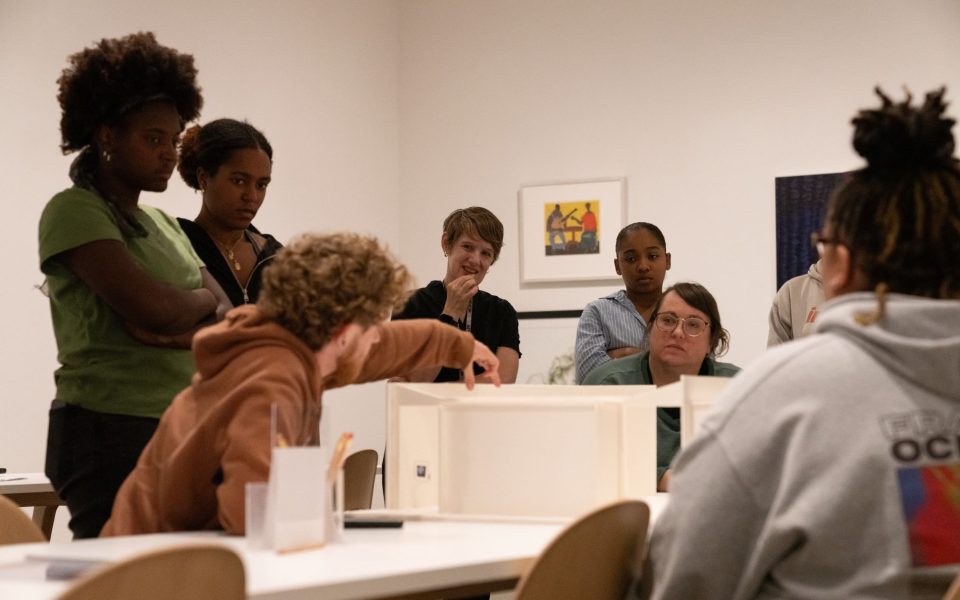Featured photo: UNCG art history students lay out the installation for an exhibition that will feature promised gifts from the Cole collection. (photo by Carolyn de Berry)
On an early Thursday morning, students file into the auditorium with the Weatherspoon Art Museum on UNCG’s campus. They scuffle through the rows and take their seats as a professor casts images of works of art onto the projected screen. This is how many students learn about art and historical objects in schools: through a digital screen.
But soon, the Weatherspoon will undergo a significant transformation to make room for a different, more immersive and intimate kind of art viewing.
In 2026, the Weatherspoon will be home to the new Cole Levin Center for Art and Human Understanding thanks to a generous gift from North Carolina artist Carol Cole Levin. The gift comprises 270 works of art from her extensive collection as well as funding for building renovations and programming.

Currently, the Weatherspoon — which was founded in 1941 — houses more than 7,000 works of art making it one of the largest collections of modern and contemporary art in the southeast. But only about half a percent of those works are on display at any given moment, according to museum staff. The rest of it sits in storage or is occasionally pulled out for students or faculty when requested. But once the new center has been built on the first floor of the museum, there will be a dedicated space that allows not just students and faculty, but the community to get closer to works of art.
“I can show students all the digital images of all the things, but it is really rare to really wrap your head around how something was put together until you’re in front of the actual thing,” says Emily Stamey, the museum’s curator of academic programming and head of exhibitions. “And that putting it together is part of its story; that is part of what the artist went through, it relates to whatever the artist was trying to tell us about themselves or what they knew about the world at that point in time.”

One of the main aspects of the new space will be an object-study gallery which will allow for close looking at a select group of objects. For example, if students are studying insects for a biology class, the faculty member can reach out to the museum and request that staff pull out works of art that correspond to the class’s topic; it creates a curated experience.
“It feels more intimate, more specialized because there’s a reason you’re coming in,” says Juliette Bianco, the associate vice chancellor for museums and creative practice and the museum director. “It’s a directed experience.”
Many of the objects that will be part of the museum’s permanent collection will be ones donated by Levin as part of the new center. An artist herself, Levin prioritized collecting works that focused on the notion of human understanding, Stamey says.

“When she chooses works to purchase or acquire, she does it because she connects with it and it shows us something about our humanity,” she says. “She’s not collecting based on market value; she’s not collecting aesthetically to decorate her home. She is collecting because she honestly believes art can save people’s lives.”
And that’s why the new center won’t just be for the campus community. Those who aren’t students or faculty will be able to access the space, too. Community groups can request a bespoke art exhibit based on their interests whether its environmentalism, health, housing or a focus on a specific culture. The goal is to foster conversations through the art of looking at objects.
“People really open up in amazing ways when you ask them to talk about works of art,” Stamey says. “I think there are conversations that happen in our galleries that don’t happen in other spaces. The art gives you a reason to be brave.”

The ability for the community to access the space puts the Weatherspoon in a different realm than other institutions that have similar spaces. More often than not, centers that already exist only cater to students and faculty. But opening up the center for everyone leads to greater human understanding, Bianco says. Thus the new name.
“We’re here to learn about each other and the world and we know that art can be a way to do that,” she says.
When a group requests an exhibit be put up for them, the works will stay up in the space temporarily so others can come view them as well, Stamey says. That creates more conversation.
“Through adding this center, we’re moving the needle from museum as a repository for objects to museum as responsive to what people want to see, think about and learn about,” Bianco says.

And that gets back to the potential for art, especially in a time of mass AI-generated content on digital platforms.
“With access to images everywhere, the sense of having access to a thing that someone made for a reason, is in a lot of ways, a lot more powerful,” Bianco says.
It harnesses attention in a way that two-dimensional objects on a screen can’t, Stamey says.
“And it’s there just for them,” Bianco says about the community’s relationship to the museum. “This museum is for them.”
Learn more about the Weatherspoon Art Museum at weatherspoonart.org.
Join the First Amendment Society, a membership that goes directly to funding TCB‘s newsroom.
We believe that reporting can save the world.
The TCB First Amendment Society recognizes the vital role of a free, unfettered press with a bundling of local experiences designed to build community, and unique engagements with our newsroom that will help you understand, and shape, local journalism’s critical role in uplifting the people in our cities.
All revenue goes directly into the newsroom as reporters’ salaries and freelance commissions.


Leave a Reply